Related Research Articles

Abstract art uses visual language of shape, form, color and line to create a composition which may exist with a degree of independence from visual references in the world.

De Stijl, also known as Neoplasticism, was a Dutch art movement founded in 1917 in Leiden. De Stijl consisted of artists and architects. In a more narrow sense, the term De Stijl is used to refer to a body of work from 1917 to 1931 founded in the Netherlands. Proponents of De Stijl advocated pure abstraction and universality by a reduction to the essentials of form and colour; they simplified visual compositions to vertical and horizontal, using only black, white and primary colors.
An art movement is a tendency or style in art with a specific common philosophy or goal, followed by a group of artists during a specific period of time, or, at least, with the heyday of the movement defined within a number of years. Art movements were especially important in modern art, when each consecutive movement was considered a new avant-garde movement. Western art had been, from the Renaissance up to the middle of the 19th century, underpinned by the logic of perspective and an attempt to reproduce an illusion of visible reality. By the end of the 19th century many artists felt a need to create a new style which would encompass the fundamental changes taking place in technology, science and philosophy.

Theo van Doesburg was a Dutch artist, who practiced painting, writing, poetry and architecture. He is best known as the founder and leader of De Stijl. He was married to artist, pianist and choreographer Nelly van Doesburg.

Neoplasticism, known in Dutch as Nieuwe Beelding or the new image, is an avant-garde art theory that arose in 1917 and was employed mainly by Dutch De Stijl artists. The most notable advocates of the theory were the painters Theo van Doesburg and Piet Mondriaan. Neoplasticism advocated for an abstract art that had been purified by applying the most elementary principles through plainly rational means. Thus, a painting that adhered to neoplastic theory would typically consist of only simple shapes and primary colors.

Victory Boogie Woogie is the last, unfinished work of the Dutch abstract painter Piet Mondrian, left incomplete when Mondrian died in New York in 1944. He was still working on it three days before dying. Since 1998 it has been in the collection of the Kunstmuseum, in The Hague. It has been said that "Mondrian's life and his affection for music are mirrored in the painting [and that it is] a testimony of the influence which New York had on Mondrian."

Piet Zwart was a Dutch photographer, typographer, and industrial designer.
Charmion von Wiegand (1896–1983) was an American journalist, abstract painter, writer, collector, benefactor and art critic. She was the daughter of Inez Royce, an artist, and Karl Henry von Wiegand. Karl Henry von Wiegand was the German-born journalist known for wartime reporting.
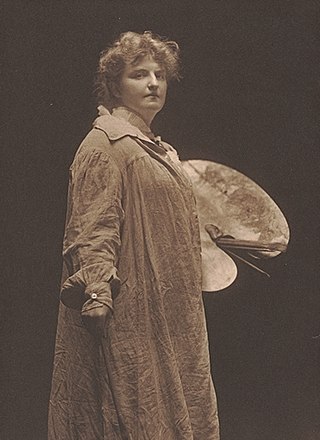
Katherine Sophie Dreier was an American artist, lecturer, patron of the arts, and social reformer. Dreier developed an interest in art at a young age and was afforded the opportunity of studying art in the United States and in Europe due to her parents' wealth and progressive attitudes. Her sister Dorothea, a Post-Impressionist painter traveled and studied with her in Europe. She was most influenced by modern art, particularly by her friend Marcel Duchamp, and due to her frustration with the poor reception that the works received, she became a supporter of other artists. She was co-founder of the Society of Independent Artists and the Société Anonyme, which had the first permanent collection of modern art, representing 175 artists and more than 800 works of art. The collection was donated to Yale University. Her works were exhibited in Europe and the United States, including the 1913 International Exhibition of Modern Art.
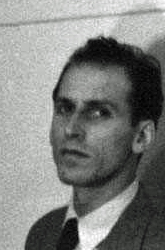
Harry Holtzman was an American artist and founding member of the American Abstract Artists group.
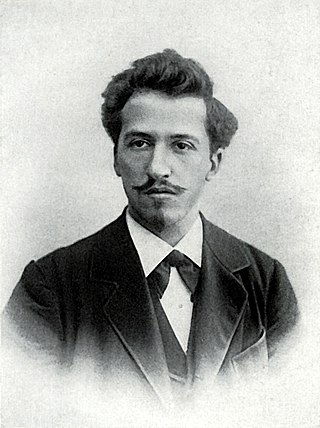
Pieter Cornelis Mondriaan, after 1906 known as Piet Mondrian, was a Dutch painter and art theoretician who is regarded as one of the greatest artists of the 20th century. He is known for being one of the pioneers of 20th-century abstract art, as he changed his artistic direction from figurative painting to an increasingly abstract style, until he reached a point where his artistic vocabulary was reduced to simple geometric elements.
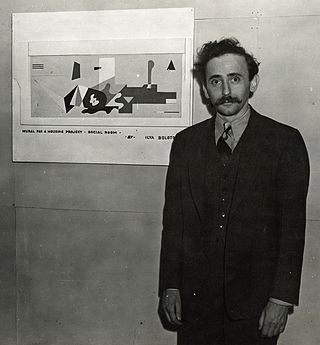
Ilya Bolotowsky was an early 20th-century Russian-American painter in abstract styles in New York City. His work, a search for philosophical order through visual expression, embraced cubism and geometric abstraction and was influenced by Dutch painter Piet Mondrian.

Sidney Jonas Budnick was an American abstract artist. He was born and raised in New York City.
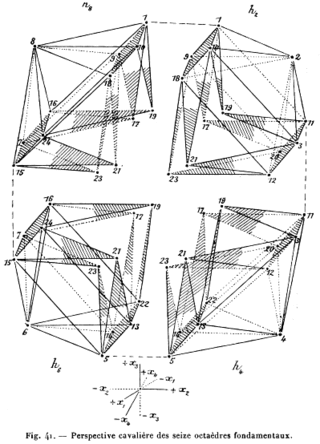
New possibilities opened up by the concept of four-dimensional space helped inspire many modern artists in the first half of the twentieth century. Early Cubists, Surrealists, Futurists, and abstract artists took ideas from higher-dimensional mathematics and used them to radically advance their work.

Annely Juda CBE was a German art dealer known for founding the Annely Juda Fine Arts gallery in London. Notable artists represented have included Anthony Caro, David Hockney and Leon Kossoff. Juda introduced several Japanese artists to the London art market.
Wanda M. Corn is an American art and cultural historian.
Christopher Kenneth Green, is a British art historian, who was professor of the History of Art at the Courtauld Institute of Art between 1991 and 2008.
Caroline A. Jones, is an American art historian, author, curator, and critic. She teaches and serves within the History Theory Criticism Section of the Department of Architecture at MIT School of Architecture and Planning, Cambridge, Massachusetts, United States.
Kathleen James-Chakraborty is a Professor of Art History and Architectural Historian at University College Dublin. She is an expert in American and German modernism, and is interested in modern sacred architecture. In 2018 She was awarded the Royal Irish Academy Gold Medal for Humanities.

Spiritualist art or spirit art or mediumistic art or psychic painting is a form of art, mainly painting, influenced by spiritualism. Spiritualism influenced art, having an influence on artistic consciousness, with spiritual art having a huge impact on what became modernism and therefore art today.
References
- 1 2 3 4 Nancy J. Troy. Stanford Department of Art and Art History. Retrieved 5 January 2017.
- ↑ Nancy J. Troy. University of Southern California. Retrieved 5 January 2017.
- ↑ The Afterlife of Piet Mondrian, by Nancy J. Troy. Tracey Warr, Times Higher Education , 1 May 2014. Retrieved 5 January 2017.
- ↑ Stanford art historian uncovers commodity culture in Mondrian's legacy. Vanessa Chang, Stanford Report, July 9, 2014.
- ↑ Nancy J. Troy. The MIT Press. Retrieved 5 January 2017.
- ↑ The Afterlife of Piet Mondrian. University of Chicago Press. Retrieved 5 January 2017.